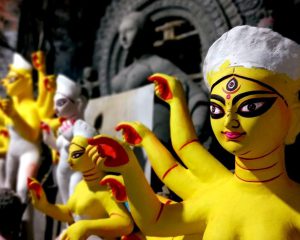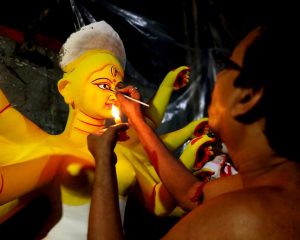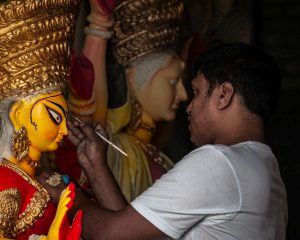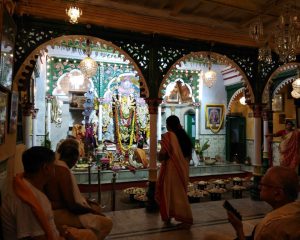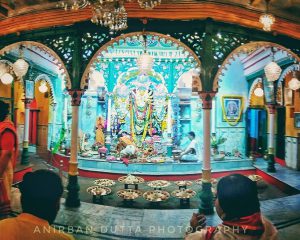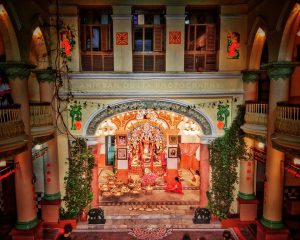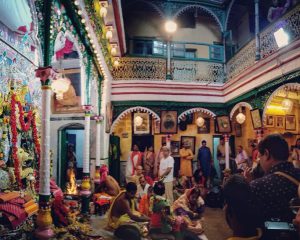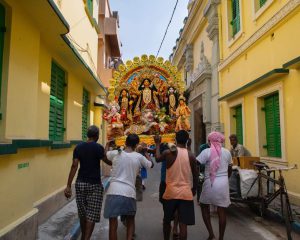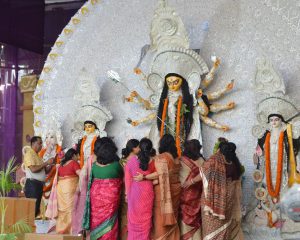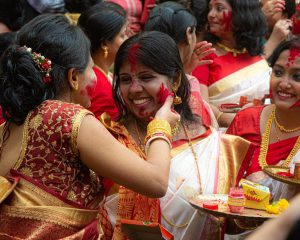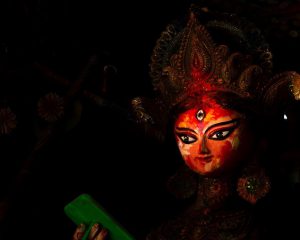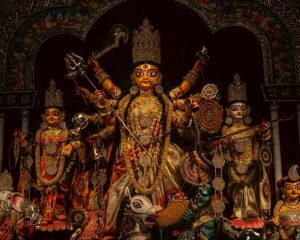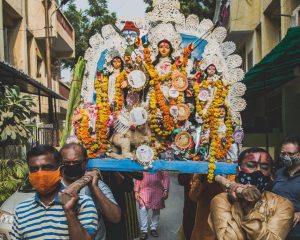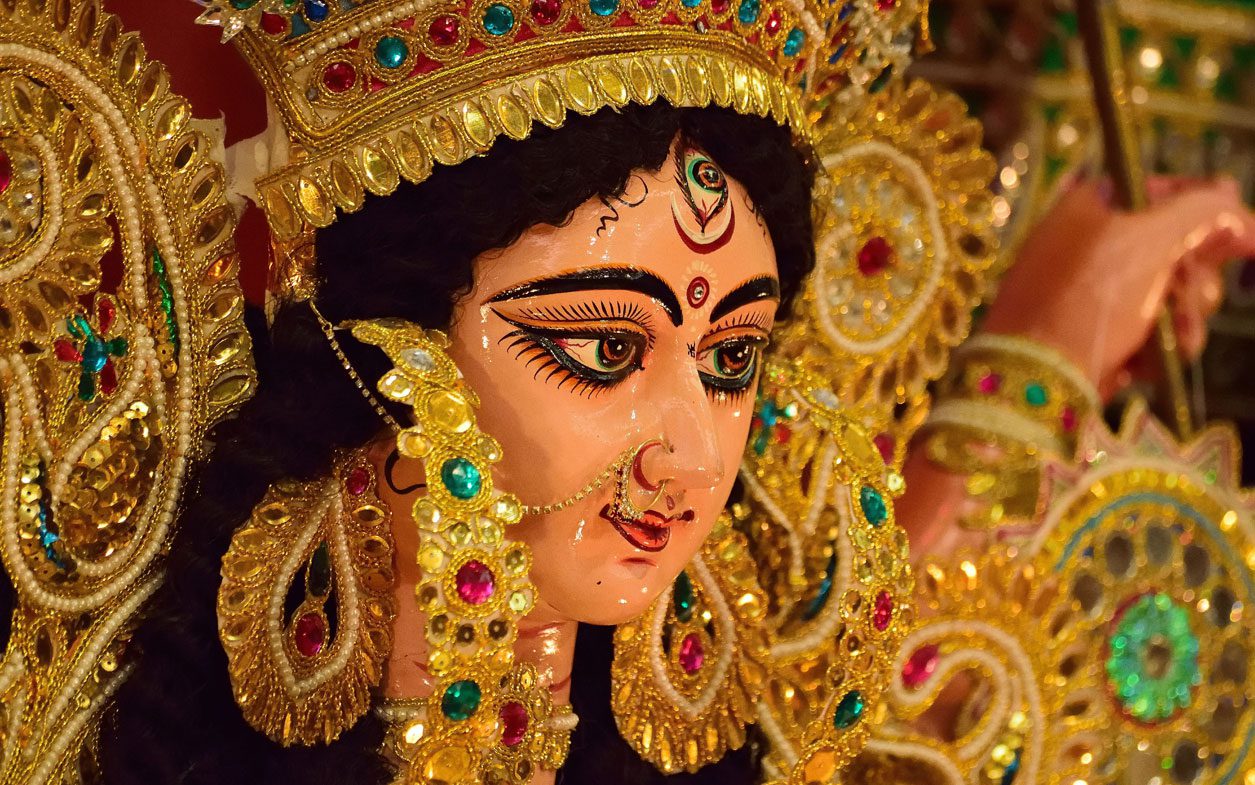
art of travel
What’s New
STAYS TO WATCH OUT FOR
New Hotels
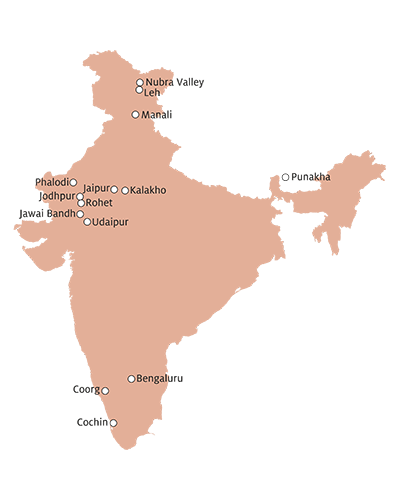
- The Kyagar, Nubra Valley
- Dolkhar, Leh
- Welcomhotel by ITC Hotels Hamsa, Manali
- Dera Village – The Clement Retreats, Kalakho
- Vanaam Ami, Jaipur
- Dera Dune, Phalodi
- Bungalow 2, Jodhpur
- Rawla Anand, Rohet
- J Wild, Jawai Bandh
- Chez Lavania, Udaipur
- Mulberry Shaders by Marriott, Bengaluru
- Marriott Resort and Spa, Coorg
- Earthen Manor, Cochin
- & Beyond Punakha River Lodge, Bhutan
We Are Excited About
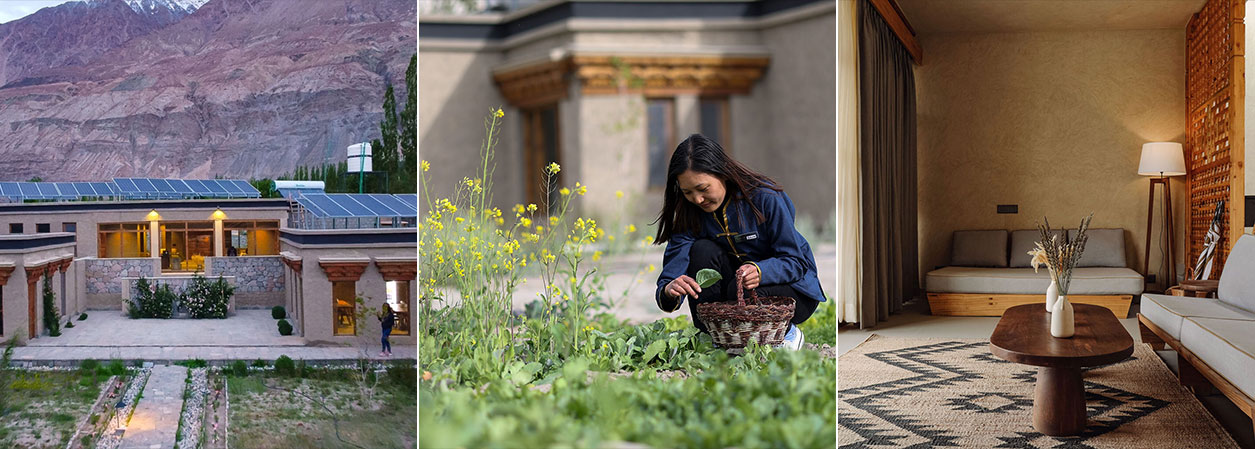
The Kyagar, Nubra Valley, Ladakh
This 16-key property, owned by Rinchen and Stanzin, is socially conscious, and community-driven. They source the ingredients locally, and everything is powered by solar energy, making Kyagar self-sustaining and leaving as little of a carbon footprint as possible. Reusable thermoses filled with hot and cold water are provided for each room. The kitchen serves a wide range of regional Indian, European, and Asian dishes. Guests staying at The Kyagar can take a stroll around the valley, sip a hot cup of tea at the 250-year-old aristocratic home, travel through space with their state-of-the-art telescope, or spend an evening by the fire. With hundreds of tiny pinpricks dotting an inky blue canvas, Nubra’s night sky is magnificent, making for a starry stay.
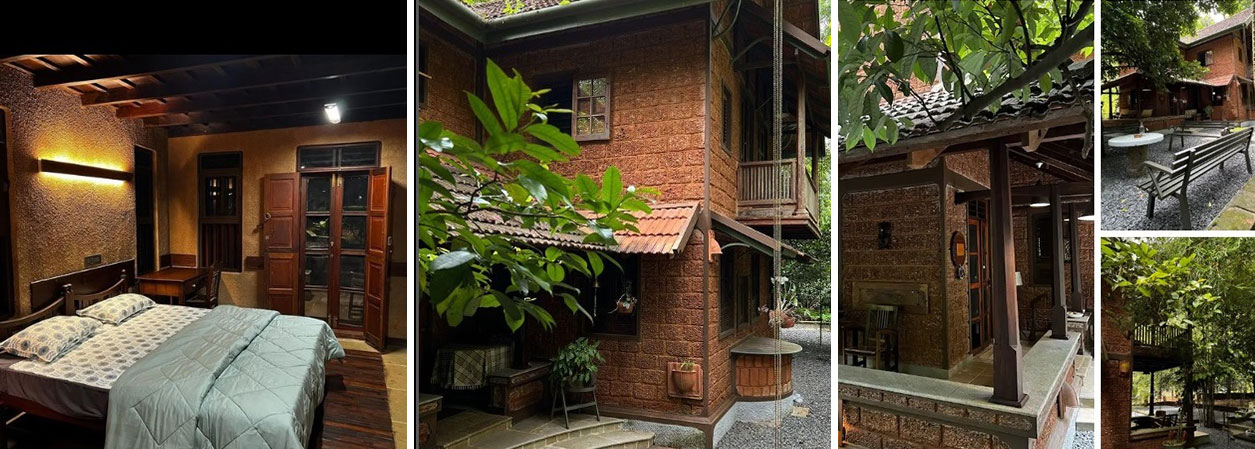
The Earthen Manor, Cochin
This cosy 2-bedroom room single key cottage is a 40 minute drive from the Cochin International Airport. An ardent believer of Slow Travel, host Deepu Paul says Earthen Manor is the place for the much needed restorative “me time” during a holiday which is why he follows the single key policy. Located amidst the canopy of a landscaped nutmeg garden, Earthen Manor has been constructed using treated mud, laterite, and recycled wood. The property is airy with an outdoor barbeque station, and a garden patio. Interiors are aesthetically equipped with all modern comforts including a fully functional kitchen. Earthen Manor makes for a perfect soft landing for guests travelling on a Kerala holiday where they can relax for a couple of days post arrival, enjoy delicious home-cooked meals over delightful conversations with the host family who stays in the same compound, and then head out to the rolling tea gardens of Munnar or the Thattekad Bird Sanctuary which is 60 minutes away.
EXPERIENCES TO WATCH OUT FOR
New Experiences
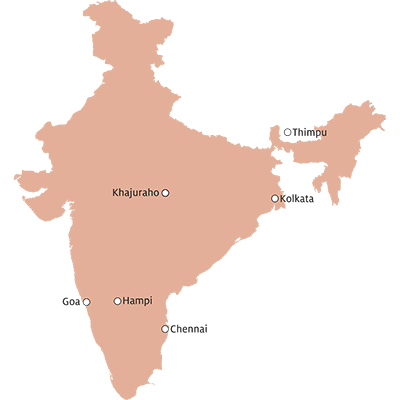
- Yoga by the temples, Khajuraho
- A Cup of History, Kolkata
- The Santhome Trail, Chennai
- Old Goa Our Way, Goa
- Mythical Hampi, Hampi
- A Delightful Tea Ritual in Thimphu
We Are Excited About
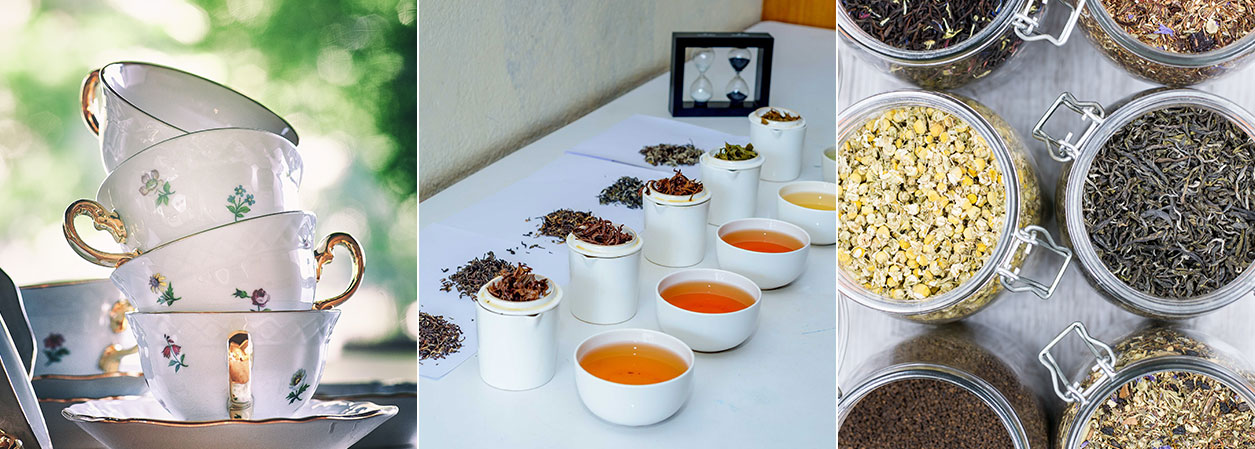
A Cup of History, Kolkata
Tea was one of the main goods shipped from Calcutta during the days of the Raj and unloaded by the Thames where the British East India Company’s warehouses were located. This tea-tasting session at the largest tasting room in the world is a fantastic opportunity to learn more about the origins of tea, the different types of tea, and brewing techniques. A must-do for anyone heading to Darjeeling and Assam, two places where the story of Tea is omnipresent!
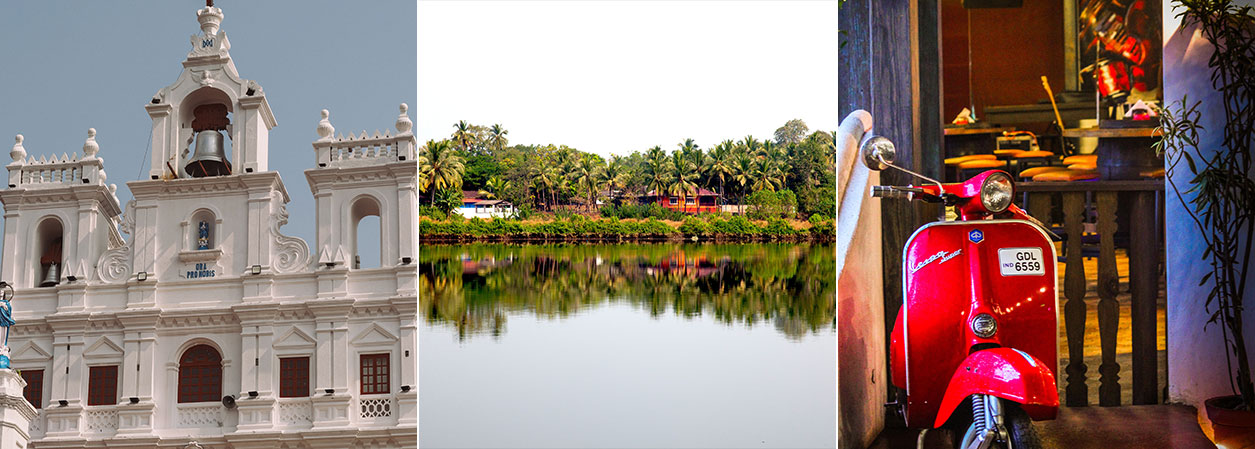
Old Goa Our Way, Goa
Goa has a rich cultural heritage with a significant influence from the Portuguese settlers who came here in the 16th century as merchants. What is today a popular beach destination was once home to many of the Catholic Religious Orders. Celebrate the aesthetic and cultural heritage of Goa with us, listen to the stories about the cloistered nuns who once lived in the Convent of Santa Monica, and discover the secret artworks that were uncovered while restoring a church.
ITINERARY OF THE MONTH
Yarns and Looms of Central India
Routing: Gwalior – Orchha – Chanderi – Sironj – Bhopal – Bahiravgarh – Indore – Maheshwar – Mandu – Indore
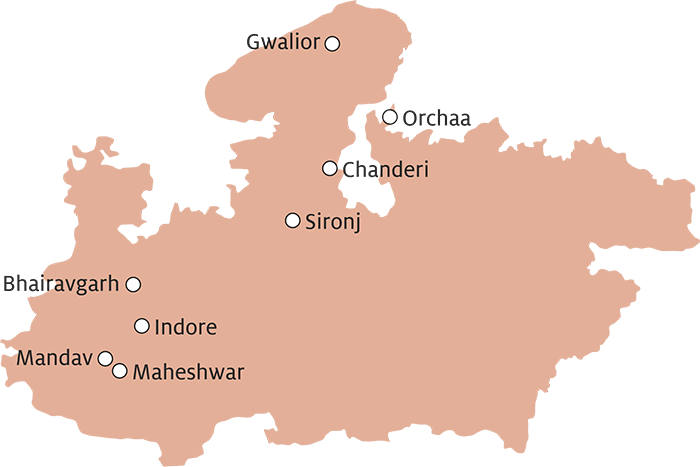
Highlights of the Tour
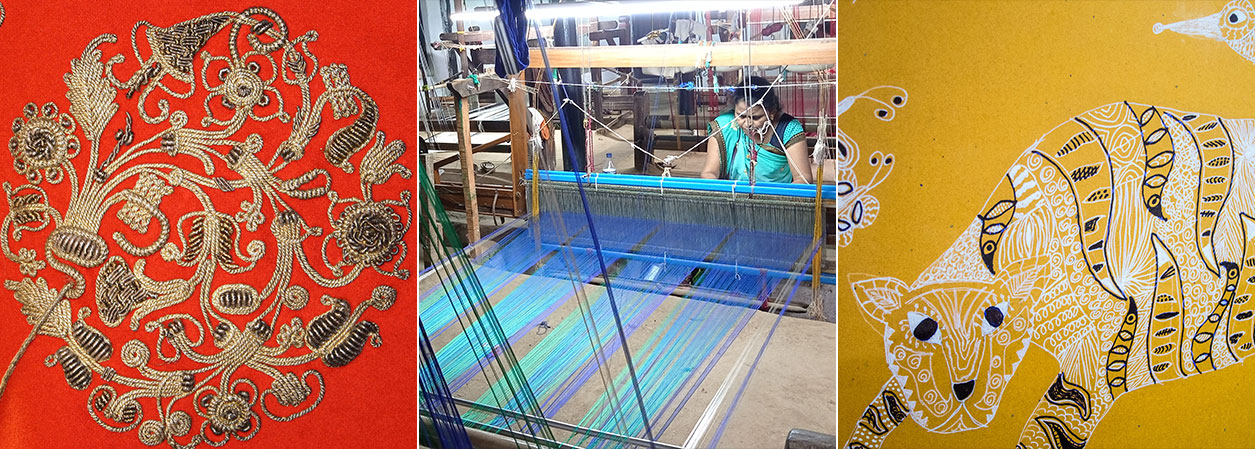
- Silk Carpet Weaving
- A meal with a master craftsman
- The Great Stupa at Sanchi
- The incredible tales of the Begums of Bhopal, a dynasty of 4 extraordinary women rulers
- Hands-on workshops – Batik Printing, Gond Painting, Zardosi Embroidery, and Block Printing.
- Silk Weaving
- Mandu’s architectural wonders
TRAVEL
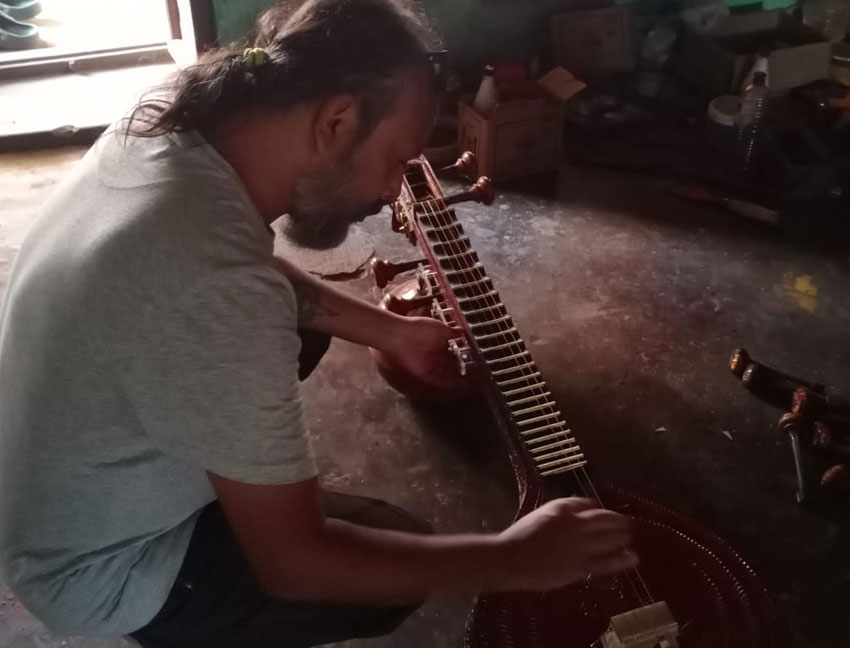
Kerala and Tamil Nadu
Kuntil Baruwa, Explorer, Destination Knowledge Centre is just back from Kerala and Tamil Nadu. Stay tuned for his report on the new discoveries in Kerala and Tamil Nadu.
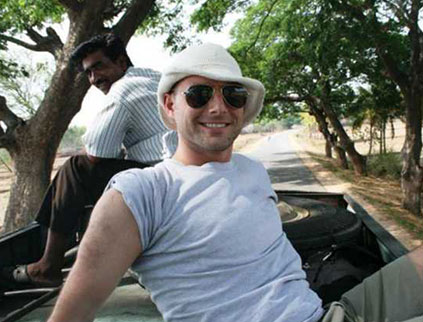
Ladakh
Jean Noel Esteve, Director Commercial, Sita Paris is just back from Ladakh. Stay tuned for his report on the new discoveries in Ladakh.
NEW SERVICES
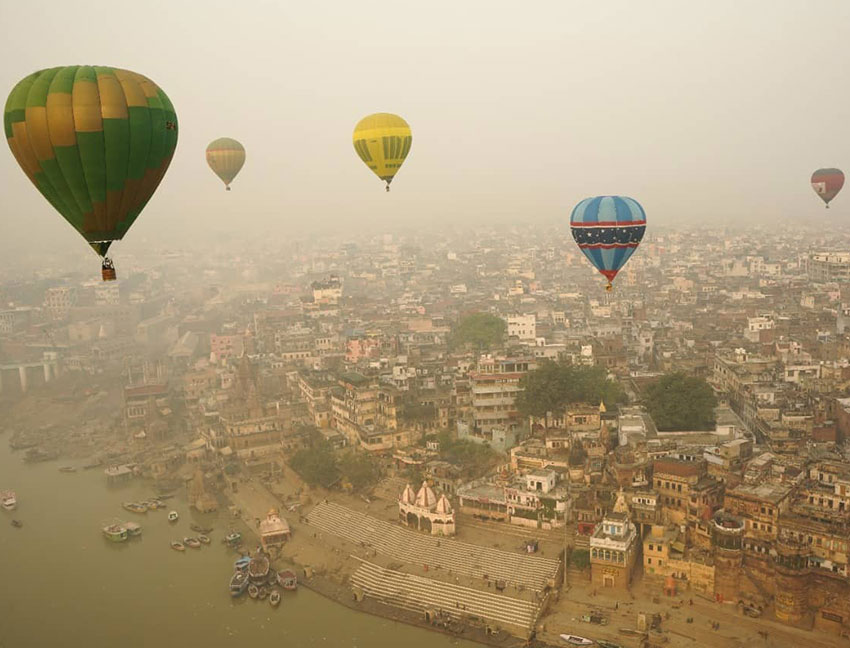
SkyWaltz to fly over Varanasi
Starting in November 2023, guests can enjoy hot air balloon rides with SkyWaltz in Varanasi.

New Daily Non-Stop Flights
- Mumbai – Srinagar – Mumbai nonstop by Vistara from 02nd September 2023. Operational 6 days a week
- Delhi – Itanagar – Delhi nonstop by Indigo Airlines from 02nd October 2023. Operational 4 days a week
- Daily nonstop flight for Delhi – Belgaum – Delhi by Indigo Airlines from 05th October 2023
- Daily Direct flight for Agra – Jaipur – Agra sector by Indigo Airlines from 29th October 2023
Get in touch with your relationship manager to know more
Stories from India
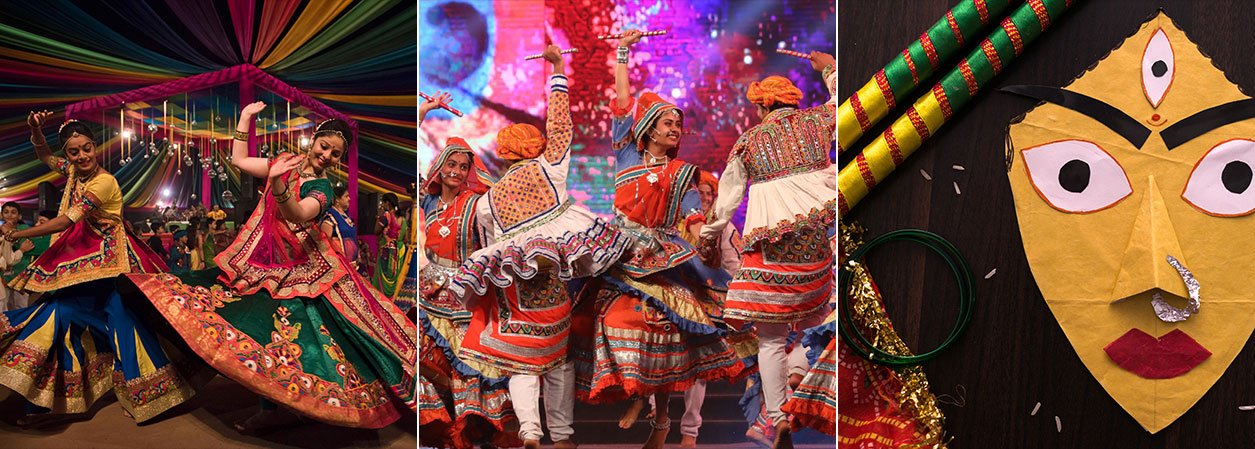
Garba
During the festival of Navratri in Gujarat which celebrates the nine forms of the Mother Goddess, Garba, a high-energy traditional dance form is performed as a devotional offering to the deity. The word Garba is derived from the Sanskrit word ‘Garbha’ meaning the womb. Garba is performed by both men and women who move in graceful and rhythmic steps in concentric circles with an illuminated earthen pot or lantern placed in the centre. The dancers clap and sing while dancing in circular movements around the lantern which symbolises the circle of life. The lantern represents the divine feminine power from which all life springs forth. Navratri coincides with the Durga Puja celebrations in West Bengal.
Women and men not only offer prayers and dance but also dress up beautifully to participate in the festival. While women wear the traditional three-piece ghaghra-choli (a traditional blouse and skirt) adorned with lovely embroidery and pieces of mirror complimented with magnificent jewellery, men are dressed up in ethnic and colourful pieces of kurtas and pyjamas with dazzling mirror work. Women also hold ornate earthen pots over their heads which make this dance form even more lively and colorful!
Ahmedabad is the best place to watch and participate in a Garba dance during the Navratri Festival held during the month of October.
Sustainability and Us
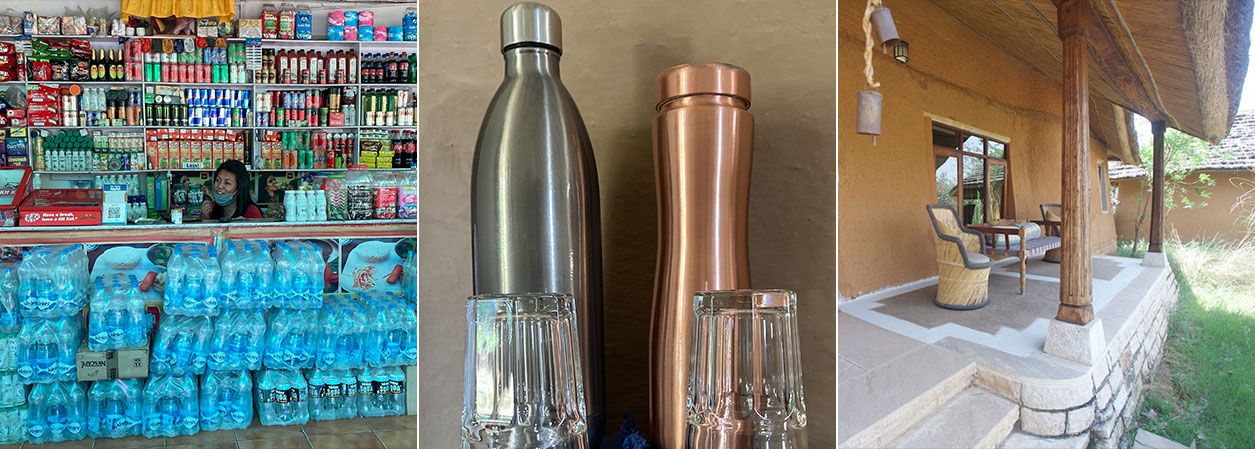
Plastic – practical, profitable but polluting: use wisely!
By Joanna Van Gruisen
I have lived in India for over 40 years now and have seen many changes. A visitor to India would appreciate many of these: better roads and connectivity, low-cost air travel, smarter trains, many wonderful new places to stay, allowing exploration to the further reaches of the country and more availability of the consumer goods familiar to inhabitants of western and – what used to be known as – first world countries. However, it is hard not to also be aware of the downside of this.
Arriving in the early 80s, India was the most exciting and thrilling place to be (it still is!); so much diversity, cultural and biological, so much connection to the land and nature, teeming with ideas and creativity. It seemed then to be a country poised to lead the world in a new direction, towards ecological economics. Sadly, this was not to be and the path chosen was the same one most of the rest of the world follows, with GDP being its measure of success. This has therefore led to many of the same problems, one of the biggest of which is waste management. In the last 50 years the world’s plastic production has grown faster than any other material: today, we produce a shocking 400 million tonnes of plastic waste every year. One million plastic bottles are purchased every minute, while up to five trillion plastic bags are used annually worldwide.
In the 80s, India was a miniscule part of these terrible statistics; there was hardly any plastic. Hard to believe now, but no plastic bags, glass not plastic bottles, paper rather than plastic packaging. Six hundred people could picnic by the Manas River in a Tiger Reserve and leave only biodegradable leaf plates and the odd paper bag. Today six people picnic by the Ken River and – if they do not throw it into the river itself! – leave behind polystyrene plates and cups, plastic bottles, plastic packaging, and aluminium cans, in short, an ugly non-biodegradable, planet-polluting mess.
India now is the fourth-highest country mismanaging waste even though our per capita use is a quarter lower than the world’s average. We now rank in sixth place in the use of plastic bottles! This is something we can all help to reduce. Efficient water filters are now ubiquitous so there is little excuse to use plastic water bottles in the tourism industry.
There is so much attention given to recycling that I feel we tend to overlook ‘Reduce’ – the first, and most important, of the three Rs. As mentioned before, the Sarai at Toria has happily run without ever providing bottled water. Early in the hotel’s life, we received a communication from a fellow hotelier in the south asking for advice about recycling his plastic bottles. While providing ideas, we also mentioned that the best way was not to use them in the first place. As often for all of us, this option had not even come to mind!
As long as increasing GDP is a country’s aim, it is hard to argue for consumption reduction. But this is truly the need of the times. Many in the tourism industry now recognise this and the new “luxury” is less, not more: thoughtful production of all that is required to make a memorable and comfortable holiday, without the waste of planet-expensive and unnecessary consumer goods. Plastic bottles come high on the latter list: let’s all avoid them.
*** This article is a part of our yearlong showcase of The Sarai at Toria’s incredible journey setting the blue print of what a responsible business in hospitality should look like. Joanna Van Gruisen is from the U.K. but she has lived in the sub-continent for over fourty years. She is a wildlife photographer, writer, conservationist and the co-owner of Sarai at Toria.
Explore
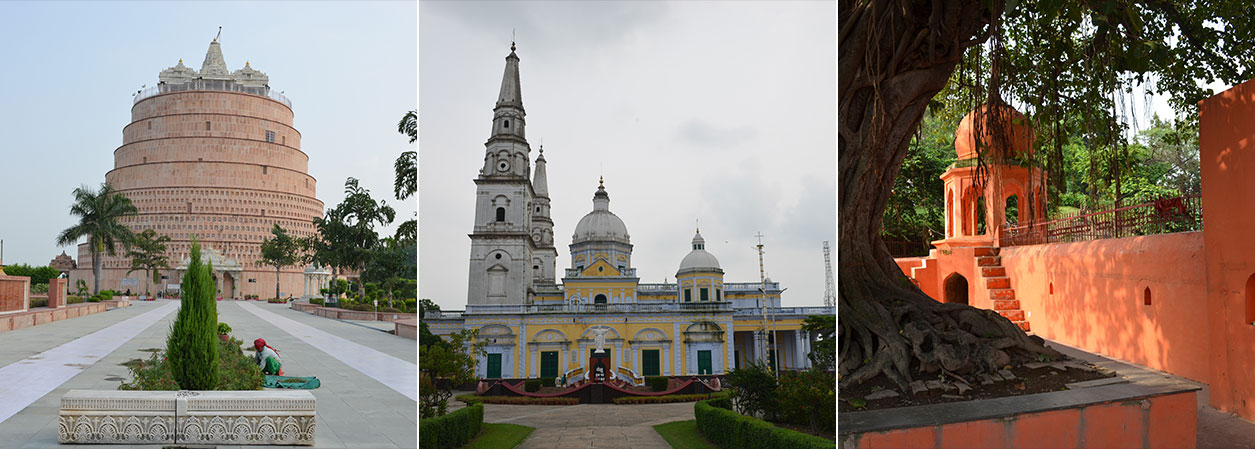
Exploring Nature and Heritage: Hapur – Meerut – Bagpat Circuit
From the Travel Diary of Inderjeet Rathod, Business Support, Destination Knowledge Centre
If you are a repeat traveller to India and heading from Delhi to Haridwar, Rishikesh, or the Corbett National Park or even further up to the hills of Kumaon, the inclusion of the Hapur – Meerut – Bagpat circuit can further enhance your travel experience. This lesser-known travel circuit unveils a tapestry of ancient roots, British heritage, rural serenity, and cultural diversity. It offers a captivating exploration of historical landmarks, architectural marvels, rural settings, and local traditions.
Rural Hapur: The Gateway to the Circuit
Hapur holds a hidden gem within its folds – Shreevanam by Beejom – a farm stay based on the concept of ‘Food Forest’ and ‘Animal Rescue’. Located just about a two-hour drive from Delhi, it offers a sanctuary of sustainability and rural serenity. This idyllic farm stay invites visitors to discover the allure of a farm stay, where nature, architecture, and mindful living converge to create a unique space.
Meerut: A City of Legends
Explore the remnants of medieval times in Meerut Cantonment / Meerut City at Shahi Eidgah, Shahpeer Sahab Ki Dargah, and the Augharnath Temple. Witness the architectural blend of Mughal and British influences at St. John’s Church, a poignant reminder of the city’s British past.
Take a detour to Sardhana town to visit sites related to British history. Visit the Church of Sardhana, also known as the Basilica of Our Lady of Graces. The town also has Begum Samru’s Palace with its unique architecture which now runs as St. Charles’ Inter College.
Who was Begum Samru? – Begum Samru was the supreme commander of 3,000 troops, including at least a hundred European mercenaries, in 18th-century northern India. She held court, wore a turban, smoked a hookah, converted from Islam to Christianity, and dubbed herself Joanna, after Joan of Arc. She married the 45-year-old Austrian mercenary Walter Reinhardt at the age of 14 and the pair teamed up and formed a formidable power couple: mercenaries for hire. After Reinhardt’s death, Begum Samru commanded an army and ruled over Sardhana for five decades and was India’s first and only Catholic Queen. Mughal kings summoned her when they were attacked by rivals. She had an ever-ready army and a knack for forging deals with anyone who attacked the Mughals. One Mughal emperor gave her the title Zeb-un-nissa (Ornament Among Women).
Bagpat: Unveiling the Rural Charms
Shikwa Haveli in Bagpat district offers a glimpse of rural life and cultural traditions of a bygone era.
Best time to visit
October to March.
Sites to visit on this circuit
MEERUT CANTONMENT
Augharnath Temple
Popularly known as ‘Kalipatan Mandir’ (or temple belonging to the ‘Black’ Brigade), it is one of the most important historical sites in the city, not popular for religious reasons but for the history it holds. This was one such centre where Indian Sepoys of the British Indian Army chalked out their operation plan during the mutiny of 1857.
St. John’s Church
Also known as Saint John the Baptist Church, it is an architectural marvel in Meerut, dating back to the early 19th century, and is one of those few heritage sites that still stand to narrate various epoch-making events, including the Mutiny of 1857. An interesting fact about John’s Church is that it is the oldest church in North India. The edifice of this famous church in Meerut still includes a large pipe organ that is non-functional.
St. John’s Cemetery
The oldest existing monument of Meerut Cantonment which was in use between the year of its establishment 1808 and 1810.
Shaheed Smarak
It is a Museum established in 1997 commemorating the mutiny of 1857. It is a must-visit for all history buffs.
MEERUT CITY
Shahi Eidgah
The 12th-century Shahi Eidgah is one of the largest mosques in Meerut and is reckoned for its exquisite architecture. The walls of this stunning mosque boast some exotic paintings that are truly a treat to the eyes. Along with that, the carvings on the walls of Eidgah beautifully reflect the craftsmanship of the bygone era.
Shahpeer Sahab ki Dargah
Constructed by Empress Noor Jahan (wife of the Mughal Emperor Jahangir) in memory of Sufi Saint Hazrat Shahpeer, this 16th-century century tomb is known for its unique architecture.
SARDHANA (about 25 km away from Meerut)
Basilica of Our Lady of Graces
This Roman Catholic Church, dedicated to the Virgin Mary was constructed by Begum Samru in the year 1781 CE. The Church is the only minor basilica in North India.
The Palace of Begum Samru
Now converted into St. Charles’ Inter College (permission is required from the principal to enter the premises), this was once the royal residence of Begum Samru, India’s first only Catholic Queen.
Anthony Kothi
This bungalow is currently being used as a hostel for the Nurses working in the adjacent Government Hospital. It was the residence of the Italian architect Antonio Reghellini, one of Begum Samru’s Military Officers who not only designed the Basilica of Our Lady of Graces but also the Palace of Begum Samru.
Begum Samru’s Family Cemetery
Here lies buried Julia Anne, the daughter of Louis Balthazar Reynaud, Samru’s son, and the mother of Dyce Sumru, the adopted son of the Begum. In this vault, too, lie some of her children who died young. Close by is the tomb of the first Julia Anne, the mother of Louis Balthazar Reynaud’s wife. As you enter the cemetery, close to the path on the left, is the grave of Le Vaisseau, the French husband of the Begum. To the right of the path, you see a number of pyramidal-shaped tombstones. These belong to the family of Reghellini, the architect of the church and palace. Many of his children died young. Close by lie the remains of Colonel Jean Remy Saleur, the officer who remained faithful to Begum Samru during the rebellion of her troops in 1795. He was witness to her marriage to Le Vaisseau. A look at the inscriptions over the tombs gives us an idea of the many foreigners that were in the service of the Begum. We find English, Italians, Portuguese, and even a native of Poland.
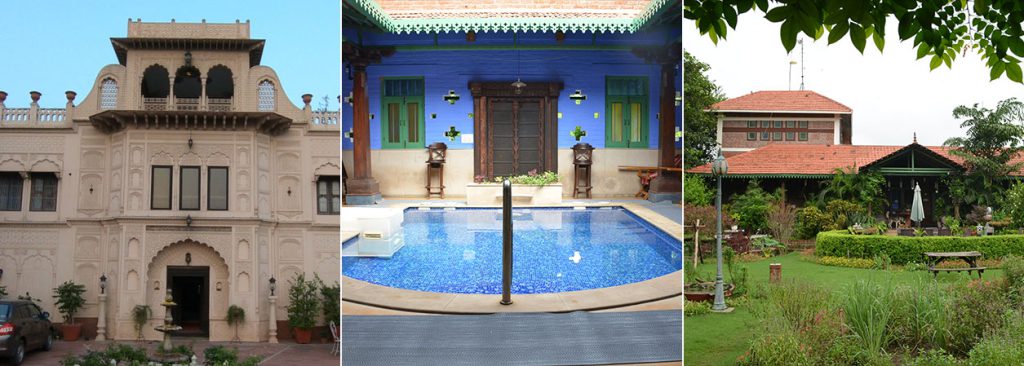
Stays we recommend
SHREEVANAM BY BEEJOM FARM (Hapur)
Location: In Bulandshahr district near Hapur, Delhi NCR
Address: Near Kuchesar Mud Fort, Village Banhpur, Uttar Pradesh 203402
Distance from Delhi: 90 km, 2 hour drive aapproximately
Overview:
Shreevanam by Beejom is a remarkably sustainable farm stay, harmoniously blending modern comforts with ecological consciousness. The homestead itself is a testament to sustainable architecture, inspired by luminaries like Laurie Baker and Geoffrey Bawa. Designed to embrace tropical living, it features spacious verandas, high ceilings, and abundant natural light. This retreat comprises three bedrooms, five bathrooms, a living and dining area, a family room, and a well-equipped kitchen.
MANGAT FARMS (Meerut)
Location: Meerut City, Delhi NCR
Address: Behind Jawaharnagar, Rotha Road Meerut City, Uttar Pradesh 250001
Distance from Delhi: 80 km, 2 hour drive aapproximately
Overview:
Mangat Farms in Meerut is a serene nature retreat set on a sprawling 50-acre farm. This farm stay provides an idyllic ambiance for relaxation and rejuvenation. Guests can explore the natural surroundings and, in winter, witness local and migratory avian species, including the majestic Sarus crane. Apart from farming activities, the farm boasts fruit-bearing trees and seasonal vegetables. Ranjit Singh, the farm’s custodian, ensures a warm and welcoming atmosphere. Visitors can savor home-cooked meals showcasing local flavors.
SHIKWA HAVELI (Bagpat)
Location: Baghpat, Delhi NCR
Address: Village Katha, Delhi – Baghpat Road, Baghpat 250609, Uttar Pradesh
Distance from Delhi: 40 km, 1.5 hour drive approximately
Overview:
Shikwa Haveli, also known as Mehrabon Wali Haveli is nestled on the banks of the Yamuna River. Located 40 km from Connaught Place, this Haveli has undergone an extensive 15-year restoration process to recapture its former glory. Today, it stands as a majestic structure adorned with chajjas, chhatris, stone jalis, and exquisite doors. It provides a unique opportunity to experience the grandeur and lifestyles of bygone royalty, with the warmth of contemporary hospitality extended by the owner, Shariq Bin Raza, and his family.
Accessibility
Meerut is best accessed from Delhi by road, being only 90 km away via the Delhi – Meerut Expressway.
Meerut lies on the main railway route from Delhi to Dehradun. Trains like Vande Bharat Express, Shatabdi Express, and Jan-Shatabdi Express from Delhi stop at Meerut City Junction.
Delhi’s Indira Gandhi International Airport, located 100 km away from Meerut is the nearest Airport.
Weaving it into an itinerary:
Delhi – Bagpat – Meerut – Haridwar – Rishikesh – Delhi
Delhi – Meerut – Hapur – Corbett National Park – Nainital – Almora – Delhi
Write to your relationship manager for a detailed itinerary
Festivals to Look Out For
Durga Puja, Kolkata West Bengal
21th to 24th October, 2023
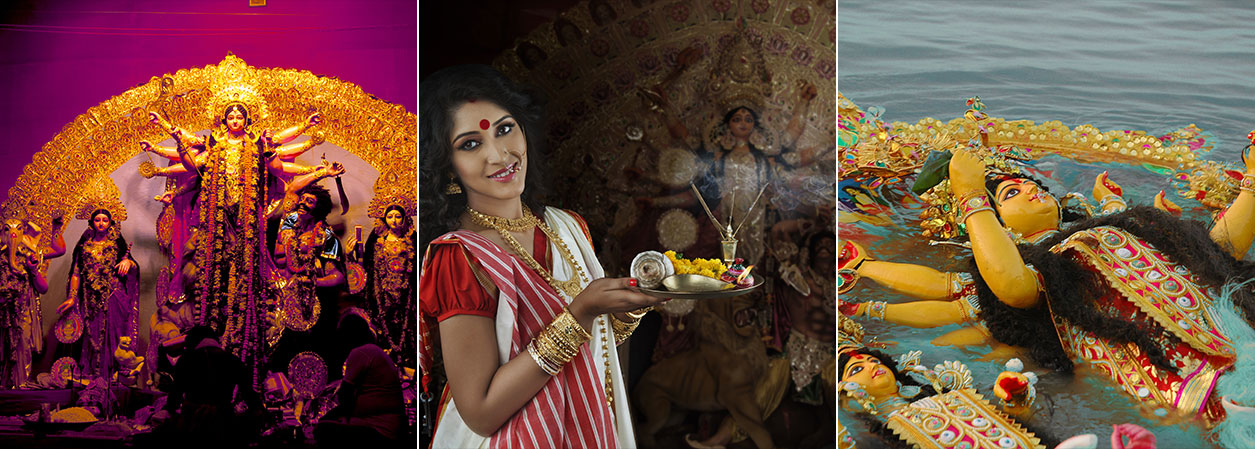
With the coming of autumn and the tell-tale nip in the air, the heart is full of hope and joy as the festivals are near!
One of the most significant festivals in India, Durga Puja is a fortnight-long celebration where people worship Shakti; the divine feminine of Hinduism. The multi-day festival is particularly fascinating in Kolkata, which has been inscribed on the list of UNESCO’s Intangible Cultural Heritage of Humanity, where it is all about exquisite idols of Goddess Durga, extravagant thematic pandals (stages), rituals, dances, good food, huge crowds and chants of “Bolo Maa Durga ki Joi” (Hail Mother Durga).
For Bengalis, autumn is equivalent to happiness as their “Ma” (mother) comes home with her children at this time. This is how homely the festivities for the Durga Puja are in Bengal and for Bengalis. It is that time of the year when they plan each day meticulously – what to dress, where to go, whom to meet, what to eat, what to cook et al. Nothing else matters. The women folk bring out all the traditional jewellery and the best traditional saris which otherwise lie wasted in some corner of the wardrobe during other times of the year. Here Durga, the great slayer of demons becomes the ever-so-dear aunt, mother, daughter, and even a friend for the people. There is revelry along with rituals for the annual homecoming like what you would expect to be unfolding when a beloved relative comes home.
Write to your relationship manager to know more about our curated tours in Kolkata during Durga Puja.
Stay at the Glenburn Penthouse, Kolkata
Just off Chowringhee Road, on the top floors of Kanak Towers, is this nine-suite oasis. Overlooking Victoria Memorial and Maidan, The Glenburn Penthouse, Calcutta is an ode to the city just like the brand’s beautiful original property, the Glenburn Tea Estate, paid homage to Darjeeling.
RESOURCES
SITE LINKS
CONTACT US
+ 91 (124) 4563000
Tower B, Delta Square, M.G. Road, Sector 25, Gurgaon - 122001, Haryana, National Capital Region of Delhi, India


